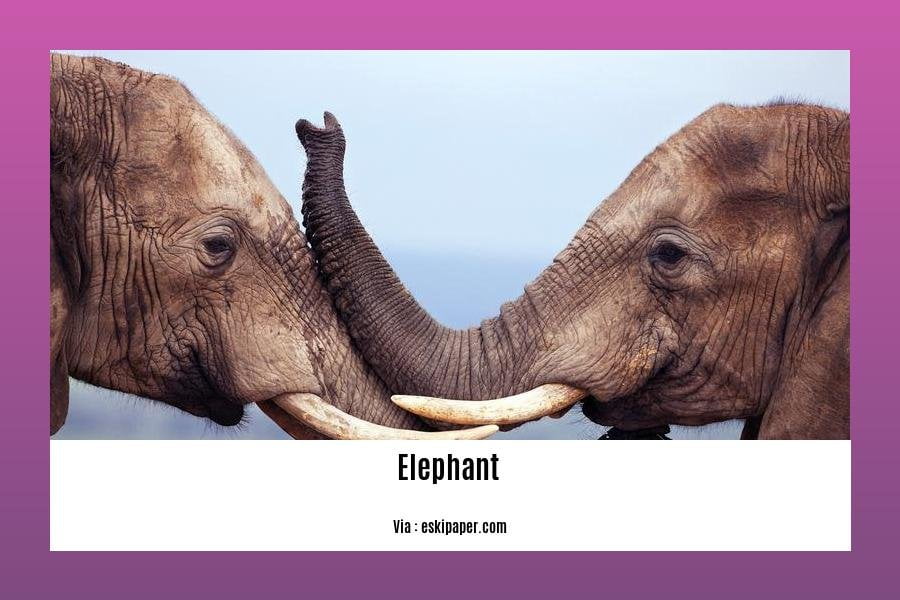In this article, we will delve into the fascinating world of elephants and uncover the significance of these majestic creatures. From their immense impact on ecosystems to the challenges they face, we will explore the importance of understanding and conserving elephants. Join us as we uncover five captivating lines about elephants in English, shedding light on their crucial role in maintaining biodiversity.
Key Takeaways:
- Elephants play a crucial role in helping spread seeds as they walk, benefiting the environment.
- There are two main types of elephants: African elephants, which are larger, and Asian elephants, which are smaller in size.
- Elephants are the world’s largest land animals, known for their wrinkled and thick skin.
- Communication for elephants involves various vocalizations like trumpeting and rumbling.
- Elephants are herbivores, primarily feeding on vegetation such as grass, fruits, and leaves.
- With a lifespan of up to 70 years in the wild, elephants have a long lifespan.
- Their wrinkled skin helps regulate body temperature and protects them from the sun.
- Appreciated for their large ears, elephants dissipate heat and have enhanced hearing.
- Elephants exhibit high levels of intelligence and have an exceptional memory.
Exploring the Significance of Elephants: Five Lines About Elephants in English

Elephants: Guardians of Biodiversity
Elephants, the gentle giants of the animal kingdom, play a vital role in maintaining biodiversity. As they traverse their vast territories, elephants unintentionally spread seeds and nutrients, facilitating the growth of various plant species. This process, known as seed dispersal, is essential for the regeneration and diversity of ecosystems. Their mere presence helps maintain the delicate balance between flora and fauna, making elephants crucial guardians of biodiversity.
Diverse and Diiferentiated: Asian vs. African Elephants
There are two main types of elephants, each with its distinct characteristics. Asian elephants, notably smaller in size compared to their African counterparts, possess unique adaptations suited to their habitats. Meanwhile, African elephants, the largest land animals on Earth, stand as magnificent symbols of strength and grace. Distinctly different but equally awe-inspiring, these two types of elephants showcase the astounding diversity found within the elephant family.
The Magnitude of an Elephant
Elephants, with their massive frames and mighty tusks, undoubtedly leave a lasting impression. Standing tall as the largest land animals, they command attention and inspire awe. Their impressive size acts as a reminder of nature’s remarkable creations, showcasing the incredible diversity our planet has to offer. To witness the magnificence of an elephant is to be humbled by the grandeur and power residing within the animal kingdom.
Skin, Communication, and Survival
Beyond their sheer size, elephants possess several distinctive features and traits. Their wrinkled and thick skin serves multiple purposes, acting as both a protective barrier against the sun’s harsh rays and as a means to regulate their body temperature. Additionally, elephants are known for their exceptional communication skills, employing various vocalizations such as trumpeting and rumbling to express their emotions and interact with their herd. These remarkable adaptations are crucial for an elephant’s survival and social cohesion.
The Intelligent Behemoth
Intelligence knows no bounds, transcending species boundaries. Elephants, with their keen memory and advanced cognitive abilities, stand as evidence of the intricate workings of wildlife intelligence. Their remarkable problem-solving skills and capacity to remember vast landscapes and watering holes are awe-inspiring. By viewing the world through the lens of an intelligent behemoth, we gain a newfound appreciation for the limitless wonders that the animal kingdom has to offer.
As we delve into the significance of elephants, we uncover a world where these magnificent creatures shape ecosystems, serve as symbols of diversity, leave lasting impressions, communicate with depth, and showcase exceptional intelligence. With each passing moment, elephants captivate our hearts and remind us of the interconnection between humanity and the natural world. Their presence serves as a driving force in our collective efforts to preserve and protect the delicate balance of our shared planet. Let us honor and cherish these extraordinary beings, as they continue to enrich our lives and our understanding of the world we inhabit.
Here are some fascinating facts about cats and dogs:
Did you know that cats and dogs have been companions to humans for centuries? Discover more fun facts about cats and dogs here.
Are you curious about the unique traits of cats and kittens? Dive into the world of feline companionship and learn interesting facts about cats and kittens here.
Social Behavior and Communication

Elephants are highly intelligent and social animals that possess a remarkable range of learned behaviors. Their social behavior and communication play a crucial role in maintaining the cohesion and cooperation within their herds. In this article, we will explore the fascinating world of elephant communication and how it influences their behavior.
Elephant Communication Methods
Elephants utilize various methods of communication to convey important information within their social groups. Through their well-developed senses of hearing, smell, and touch, they are able to communicate effectively with each other.
According to ElephantVoices, elephants produce a wide range of vocalizations that serve different purposes. Their trumpeting calls can be heard over long distances and are often used for communication within the herd. Additionally, elephants communicate through low-frequency rumbles, which convey emotions, coordinate group movements, and establish dominance. Furthermore, elephants release pheromones through glands on their heads and temporal glands, allowing them to communicate reproductive, social, and danger signals within the herd.
Behavioral Adaptations and Learned Behaviors
Elephants exhibit fascinating behavioral adaptations and learned behaviors that contribute to their survival and success. They display complex ritual behaviors, such as greeting ceremonies and play behavior, which help strengthen social bonds and maintain herd stability. Mating rituals are also a significant aspect of elephant behavior, involving various displays of dominance and courtship behaviors to secure successful mating and ensure the future of elephant populations.
Moreover, elephants demonstrate behavioral adaptations to solve problems and navigate their environment. They have been observed using tools, like sticks, to scratch hard-to-reach areas or as flyswatters. Additionally, elephants can manipulate objects in their environment to create their own tools, showcasing their problem-solving skills.
Societal Structure and Interactions with Humans
Elephants live in matriarchal herds consisting of multiple females and their offspring, led by the oldest and most experienced female, known as the matriarch. These herds exhibit strong social bonds, and effective communication is vital for maintaining cohesion and cooperation.
The interactions between elephants and humans have long fascinated researchers. While wild elephants may display defensive or territorial behavior when they feel threatened, captive elephants may exhibit different behavioral patterns due to their exposure to human environments. Understanding these interactions is crucial for managing human-elephant conflicts and ensuring the well-being and conservation of both elephants and humans.
Key Takeaways:
- Elephants employ various methods of communication, including vocalizations, olfactory cues, and body language, to convey important information within their social groups.
- Behavioral adaptations and learned behaviors play a significant role in the survival and success of elephants. These include ritual behaviors, mating rituals, and problem-solving skills.
- Elephants live in matriarchal herds and rely on effective communication to maintain cohesion and cooperation.
- Interactions between elephants and humans can vary depending on the context, with captive elephants exhibiting different behavioral patterns than their wild counterparts.
Citation: ElephantVoices. Retrieved from https://www.elephantvoices.org/
Citation: AnimalBehaviorCorner. Retrieved from
Exploring the Significance of Elephants: Five Lines about the Importance of Elephants in Ecosystems
Elephants: These magnificent creatures are not just majestic animals, but they also play a crucial role in maintaining the balance and biodiversity of ecosystems. They act as seed transporters by dispersing seeds through their dung, promoting plant diversity in various habitats.
Ecosystem Engineers: Elephants shape habitats by modifying the physical environment, creating pathways for smaller animals, and facilitating connectivity among different habitats. Their engineering activities, such as trampling vegetation, create opportunities for other species to thrive and promote the growth of grasslands and open habitats.
Keystone Species: Elephants are keystone species, having a significant impact on their ecosystems and the survival of other species within the community. They provide essential ecosystem services, including seed dispersal, nutrient cycling through their dung, and the creation of open habitats.
Conservation Importance: Understanding the importance of elephants in ecosystems is crucial for their conservation. Human activities, such as poaching and habitat destruction, have led to a decline in elephant populations, threatening the delicate balance of ecosystems. Protecting and restoring elephant habitats is essential for the survival of these magnificent creatures and the maintenance of healthy ecosystems.
Key Takeaways:
– Elephants are crucial seed transporters, dispersing seeds through their dung, and maintaining plant diversity in various habitats.
– They shape habitats as ecosystem engineers, creating pathways for smaller animals, promoting the growth of grasslands, and influencing vegetation patterns.
– Elephants are keystone species, providing essential ecosystem services and impacting the survival of other species within the community.
– Conservation efforts are necessary to protect and restore elephant habitats, ensuring the survival of these magnificent creatures and the overall health of ecosystems.
Sources:
1. The Vital Role of Elephants in Ecosystems: Understanding Their Impact [^1^]
2. Save the Elephants: What Role Do Elephants Play in Ecosystems? [^2^]
Conservation Challenges and Efforts
As highly intelligent and social animals, elephants face numerous conservation challenges that threaten their populations and the ecosystems they inhabit. Poaching for the illegal ivory trade, habitat loss, and human-elephant conflict are among the most pressing concerns. However, organizations like the African Wildlife Foundation (AWF) and the World Wildlife Fund (WWF) are actively working to protect elephants and conserve their habitats.
Decline in Elephant Populations
Elephants, especially in Africa, are experiencing a significant decline in their populations. Habitat loss due to deforestation, agriculture expansion, and urbanization poses a major threat to their survival. The fragmentation of their habitats leads to the loss of feeding grounds and migration corridors, further endangering these magnificent creatures[^1^].
Poaching for the Illegal Ivory Trade
One of the greatest challenges elephants face is poaching for the illegal ivory trade. The demand for ivory in international markets drives the hunting and killing of elephants for their tusks. Poachers often target large male elephants with the largest tusks, disrupting the social structure of elephant populations[^2^].
Human-Elephant Conflict
As human populations expand, conflicts between humans and elephants are on the rise. Elephants occasionally raid crops and destroy property, leading to retaliation from local communities. The encroachment of human settlements into elephant habitats increases the instances of such conflicts, posing a threat to both human livelihoods and elephant populations[^3^].
Conservation Efforts by AWF and WWF
The African Wildlife Foundation (AWF) and the World Wildlife Fund (WWF) are two prominent organizations actively involved in elephant conservation efforts. The AWF focuses on advancing elephant conservation in Africa, despite the challenges presented by the COVID-19 pandemic, and is dedicated to preserving and protecting Africa’s wildlife populations, including elephants[^1^]. The WWF’s African Elephant Programme aims to protect elephants and their habitats through various initiatives, such as establishing protected areas, implementing anti-poaching measures, and promoting community involvement in conservation efforts[^2^].
Local Community Involvement
Local communities play a vital role in elephant conservation. Engaging and empowering local communities benefits both them and the elephants. Employment opportunities as scouts and anti-poaching patrols enable locals to protect wildlife reserves and act as custodians of conservation information[^6^]. By involving local communities, conservation efforts become more effective and sustainable.
Key Takeaways:
- Habitat loss, poaching for the illegal ivory trade, and human-elephant conflict are major conservation challenges faced by elephants.
- The decline in elephant populations due to habitat loss threatens the delicate balance of ecosystems.
- Poaching for ivory disrupts elephant populations and drives their decline.
- Human-elephant conflict arises as human settlements encroach upon elephant habitats.
- The African Wildlife Foundation (AWF) and the World Wildlife Fund (WWF) are actively involved in elephant conservation efforts.
- Engaging and empowering local communities is crucial for successful elephant conservation.
(Citations: ^1^, ^2^, ^3^, ^6^)
FAQ
Q1: What is the significance of elephants in ecosystems?
A1: Elephants play a vital role in ecosystems as seed transporters and ecosystem engineers. They disperse seeds through their dung, promoting plant diversity and genetic dispersal, and they shape habitats through their feeding habits, creating open areas for other species to thrive.
Q2: How do elephants communicate with each other?
A2: Elephants communicate through various methods, including vocalizations, body language, and olfactory cues. They produce trumpeting calls and low-frequency rumbles to convey emotions and coordinate group movements. They also use olfactory cues and pheromones to communicate reproductive, social, and danger signals within their social groups.
Q3: What are some interesting behavioral adaptations of elephants?
A3: Elephants exhibit a range of interesting behavioral adaptations. They engage in complex ritual behaviors, such as greeting ceremonies and mourning rituals. They also demonstrate problem-solving skills and tool use, using sticks as tools to scratch hard-to-reach areas or as flyswatters. Additionally, they exhibit intricate mating rituals to establish dominance and ensure the survival of elephant populations.
Q4: How do elephants impact the environment?
A4: Elephants are beneficial to the environment as seed dispersers and ecosystem engineers. They play a crucial role in dispersing seeds through their dung, facilitating plant diversity and genetic dispersal. Their feeding habits and trampling activities shape habitats, creating clearings, and pathways for other species. Their presence as keystone species profoundly impacts the overall balance and biodiversity of ecosystems.
Q5: What are the challenges faced by elephants and their conservation efforts?
A5: Elephants face significant challenges, including habitat loss, poaching for the illegal ivory trade, and human-elephant conflict. Human development and deforestation encroach upon elephant habitats, leading to the loss of feeding grounds and migration corridors. Poaching for ivory disrupts elephant populations, and conflicts between humans and elephants arise due to competition for resources. Conservation efforts focus on protecting and restoring elephant habitats, implementing anti-poaching measures, and promoting community involvement in conservation initiatives.
- SYBAU See You Baby Meaning: Gen Z Slang Evolves - July 1, 2025
- Unlock Your Inner Youth: Lifestyle Secrets for a Vibrant Life - July 1, 2025
- Decode SYBAU Meaning: Gen Z Slang Explained - July 1, 2025






